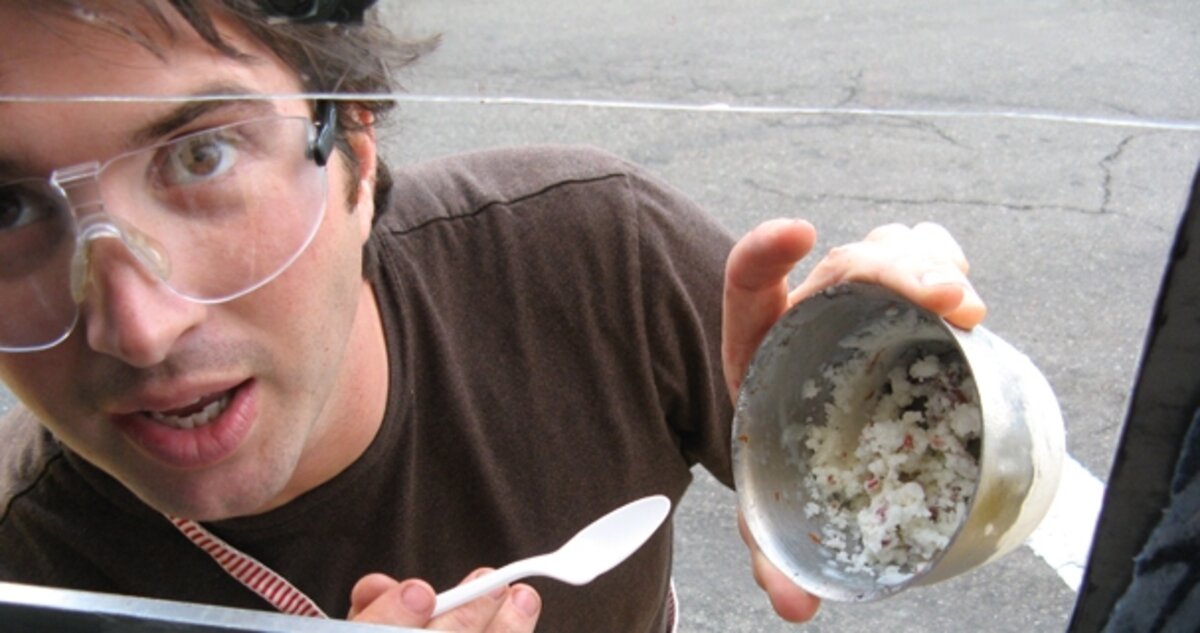The art and science of playing with your food
Loading...
At an ice-cream booth, Patrick Buckley dished out ice cream to attendees of Maker Faire, a do-it-yourself festival held earlier this month in Austin, Texas. With flavors such as frozen mint cucumber lime and BBQ honey, the treats were far from traditional. Nor were they handchurned the old-fashioned way, with the required hour-long wait before serving.
Instead, Mr. Buckley and a group of so-called āhungry scientistsā were serving instant, microbatch cryogenic ice cream, frozen in about 30-second intervals using liquid nitrogen.
āFoodās always been a focal point for communities,ā says Buckley. āWeāre just doing that with a twist of interesting new technology.ā
While the latest developments in experimental and scientific cooking, known as molecular gastronomy, might originate from the high temples of haute cuisine, a group of part-time tinkerers have been exploring quirky cooking at home.
The hungry scientists have whipped up everything from lollipops embedded with LED lights to a modular pecan pie using a basic understanding of structural engineering.
āItās like āMr. Wizardā meets āIron Chef,ā ā says Ryan Horan, a baker from Somerville, Mass. āPeople cobble things together in their house.ā
This do-it-yourself spirit sets them apart from formal food scientists, he says. ā āMolecular gastronomyā is an almost foreboding term. It almost makes you seem like a food snob,ā Mr. Horan says. āA āhungry scientist,ā itās more like a tinkerer in the garage, working under the hood of a Ford.ā
These cooks combine lab materials ā dry ice and circuit boards, for example ā with traditional ingredients, such as powdered sugar and whole milk. Borrowing a page of the open-source software world, they post their favorite innovations on websites such as instructables.com and hungryscientist.com.
Buckley, along with friend and cookbook author Lily Binns, recently wrote āThe Hungry Scientist Handbook: Electric Birthday Cakes, Edible Origami, and Other DIY Projects for Techies, Tinkerers, and Foodies.ā The book contains 20 projects that range from solar-powered, heat-sensing coasters (that change colors depending on the temperature of a personās glass or cup); portable stoves made out of the bottoms of aluminum cans; and Ć¼berbubbly root beer.
To boldly go where no cook has gone before
The group started with a dinner party at Buckleyās home in the San Francisco Bay Area. āIt was Patrick and his friends,ā Ms. Binns says. āThey were not paying a premium to eat at restaurants; they were treating food like any other techie project or craft: taking apart food like they were doing any other project.ā
They carefully disassembled regular recipes and customized them to fit their tastes, creating projects for the handbook that are both practical and whimsical.
āThere are two approaches,ā Horan says. āThere are folks who are interested in more classic elements, like baking.... And then, thereās food as fun, like the electric birthday cake. I say, if it gets people involved in food and more interested in food, I think thatās so much the better.ā
Molecular gastronomy is said to have begun as a series of workshops in Erice, Italy, in the early 1990s. The science gave rise to curious new kitchen techniques, such as controlled gelification of liquid balls of food, or spherification. (This means chefs can make caviar-like foods out of any liquid.)
Chefs are also using scent-infused foams and slow-cooking meats in liquid (sous-vide) at low temperatures, all of which stir elements of science into the mix.
The success of these pioneering techniques has now hit bookstores. At least three mammoth cookbooks describing the avant-garde cuisine debuted in October.
High-end grocery stores, such as New Yorkās Dean & DeLuca, now sell $200 home kits that include syringes, agar, xanthan gum, and lecithin ā tools and chemicals that were once confined to the research and development labs of food companies but have now been retailored for home cooks.
Gastronomy is an acquired taste
It may be years before molecular cooking reaches the everyday kitchen. For now, many home chefs, if they cook with raw ingredients at all, seem content with simpler kitchen conundrums: understanding the science behind gooey potatoes, green garlic, or soft-boiled eggs.
āItās only recently that innovation has been important in cooking,ā says Harold McGee, author of āOn Food and Cooking, the Science and Lore of the Kitchen.ā āItās mostly been about traditional recipes and executing traditional techniques better than anyone else. That started to change a bit in the 1970s. It wasnāt until the end of last century, the beginning of this century, that innovation was a goal of chefs as a way to distinguish their restaurants from other restaurants. I think it will take a while for eaters to become as interested in these innovations as chefs.ā
Sometimes, the tools of gastronomists are enough to scare away casual cooks. An accurate scale that weighs to a tenth of a gram ā the kind of laboratory instrument needed to weigh ingredients for spherifying foods ā costs as much as $1,500.
On the other side of the table, hungry scientists devise inexpensive ways to procure Dewars, stainless steel vacuum flasks that protect people who handle liquid nitrogen.
Thatās one reason hungry scientists differ from sophisticated gastronomes and chefs at some of the worldās most exclusive restaurants, Binns says.
āI think both are about experimentation and playfulness,ā she says. āI donāt want to make it seem like weāre better or cooler than what theyāre doing. But they are serving a mainstream of wealthy culture. Even though theyāre rooted in the same scientific pursuits, I think itās like comparing apples to orangesā¦. They are performers and the people who go to those restaurants are paying a lot to be their audience."




